-
PDF
- Split View
-
Views
-
Cite
Cite
James C. Halstead, David Spielvogel, Dieter M. Meier, Sindy Rinke, Carol Bodian, Ramin Malekan, M. Arisan Ergin, Randall B. Griepp, Composite aortic root replacement in acute type A dissection: time to rethink the indications?, European Journal of Cardio-Thoracic Surgery, Volume 27, Issue 4, April 2005, Pages 626–632, https://doi.org/10.1016/j.ejcts.2004.12.059
Close - Share Icon Share
Abstract
Objective: The indications for aortic root replacement in acute type A dissection are unclear. We reviewed the immediate and long-term outcome of consecutive patients in a series in which a low-threshold policy of composite aortic root replacement had evolved. Methods: From a prospectively compiled aortic surgery database, we identified 162 patients who had either supracoronary interposition grafting, Group A (n=89), or composite root replacement, Group B (n=73) for acute type A dissection. Patients receiving total arch replacements were excluded. Operative and clinical details were analyzed and patient survival was compared to an age and gender matched census cohort. Need for reoperation on the proximal or distal aorta was also noted. Follow-up totaled 795.5 patient-years. Results: Hospital mortality rates were identical in both groups (12.3%: 11 deaths in group A; 9 in group B). Chronic pulmonary disease, diabetes, malperfusion, hemodynamic compromise and aortic root dilatation were independent risk factors for hospital death. Actuarial survival estimates at 1, 5 and 10 years were 79% (71–88%), 64% (53–75%), and 55% (41–68%) for group A, and 79% (70–86%), 73% (62–83%), and 65% (52–78%) for group B (P=0.48). Age and operative patency of the ascending false lumen were independent risk factors for death after hospital discharge. Proximal aortic reoperation was required for four patients in group A and none in group B (P=0.085). Conclusion: A strategy of replacement rather than repair of the dissected aortic root for specific indications in type A dissection yielded high survival and low proximal reoperation rates. These results support an aggressive policy of composite root replacement in acute type A dissection.
1 Introduction
Since the first successful surgical treatment of acute type A dissection, various techniques have been developed to preserve the integrity of the aortic valve and the sinuses while replacing the supracoronary aorta. Of necessity, these methods require repair of dissected tissues at the root using external, internal or intramural reinforcement with prosthetic or biological materials [1]. The introduction of tissue glues was heralded as a marked improvement over earlier techniques [2]. But although substantially improved immediate surgical mortality following initial procedures for acute type A dissection was soon forthcoming, for many patients the long-term outlook remained bleak because of limited durability of the repair, with residual problems arising from dissected tissues left at the root [3,4]. Methods that allow elimination of all dissected tissues at the root—including replacement of the root with a composite valved conduit [5], and valve-sparing root replacement [6]—are relatively recent additions to the surgical treatment of acute type A dissection. Whether these more extensive procedures—with possible additional operative risk—can be justified for the potential benefit of long-term results continues to be a subject of active debate [7,8]. We have previously reported that composite graft replacement of the aortic root in selected patients with acute type A dissection can be performed with comparable perioperative mortality and better long-term event-free survival than a more limited operation [5]. We have used composite replacement of the aortic root preferentially in all patients with acute type A dissection when there was extensive dissection of the sinuses or of the coronary ostia, and in the presence of dilated aortic sinuses or severe aortic regurgitation. The following is the analysis of the outcomes of this relatively aggressive strategy in a consecutive series of patients.
2 Materials and methods
2.1 Patient data abstraction
The aortic surgery database at Mount Sinai Medical Center contains 179 consecutive patients who underwent surgery for acute type A dissection between January 1986 and April 2003. Of these, 17 patients underwent total arch replacement (with or without intervention on the descending thoracic aorta) in addition to ascending aortic replacement: these more complex patients were excluded from the analysis. The remaining 162 patients were grouped according to the technique of proximal repair. Group A (n=89, 54.9%) had interposition graft replacement of the ascending aorta with resuspension, repair or separate replacement of the aortic valve (Table 1). Group B (n=73, 45.1%) underwent composite graft replacement of the aortic root and ascending aorta. The extent of distal resection in these patients is also shown in Table 1. The patients' clinical characteristics, including comorbidities and hemodynamic status at presentation, are shown with between-group comparisons in Table 2.
The diagnosis of acute type A dissection was made by preoperative imaging (computed tomography, magnetic resonance imaging, aortography or echocardiography) or at surgery. Each thoracic aortic segment was classified as containing either a patent or clotted false lumen, or being unaffected by the dissection process (by definition only arch and descending segments). The severity of proximal dissection was estimated by noting whether there was aortic root dilatation, aortic regurgitation and/or coronary ostial dissection or tear. The location of the intimal tear, where identifiable, was also recorded (Table 3).
2.2 Operative procedures
Whilst surgical techniques evolved somewhat over the time course of this series, the basic principles involved replacement of the ascending aorta and resection of the primary intimal tear, with the construction of an open distal anastomosis during a period of hypothermic circulatory arrest. The site of arterial cannulation changed with time, with preferential use of the right axillary artery over the femoral artery in recent years. In all patients, regardless of the site of the arterial cannula, the flow pattern in the descending aorta was carefully monitored by transesophageal echocardiography at the start of perfusion to avoid malperfusion. During cooling, the aorta and heart were not manipulated until ventricular fibrillation occurred. The ascending aorta was then cross-clamped in its distal half and the aorta was opened. Cardioplegia was delivered directly into the coronary ostia, and the aortic root pathology assessed.
The extent of operation was determined according to the preference of the surgeon in accordance with the following general guidelines. Composite graft replacement was used almost exclusively whenever the coronary sinuses were dissected. Only where the dissection at the root was limited to the non-coronary sinus and the dissected tissues could be completely removed by scalloping this sinus to the annulus was repair of the root undertaken with a tailored graft. When aortic root enlargement with aortic regurgitation was found (including Marfan's syndrome), repair was only undertaken in the cases of milder incompetence or lesser degrees of dilatation. An aggressive strategy of resection rather than repair of the dissected aortic root has resulted in a high proportion of composite graft replacements in this series.
When conservative repair was undertaken, the aorta was transected at the sinotubular junction and reinforced with an externally placed circumferential piece of Teflon® felt and an internal gusset of felt or autologous pericardium, so as to realign the commissural geometry (81 patients). Where the non-coronary sinus was dissected, it was excised to the annulus and the graft tailored to accommodate the resultant defect. Tissue glues were not used. In five patients, separate valve replacement (with three mechanical and two stented bioprostheses) was undertaken in cases of bicuspid, stenotic, or residually regurgitant valves. In two patients, complex repair of the aortic valve was performed, and in one patient a valve-sparing (remodeling) root replacement was undertaken.
A premanufactured conduit with a mechanical valve was used in 62 patients. In 11 patients, a biological valve was sutured to an appropriately sized tubular woven graft. By far the commonest strategy for composite root replacement (54 patients, 74%) involved the reimplantation of the coronary arteries as separate buttons on the outside of the graft (button-Bentall technique). A classic Bentall procedure was used in three patients: the in situ coronary orifices were anastomosed to the conduit, which was then enclosed with the residual aortic tissue [9]. The Cabrol modification of the Bentall procedure was performed in 15 patients: in 12 of these, the Cabrol graft was sutured to buttons of reconstructed coronary ostia that were involved in the dissection [5]; in the remainder, the ostia were left in situ [10]. In one patient with previous coronary artery bypass grafts, the native coronary arteries were ligated and the proximal aortocoronary graft anastomoses reimplanted on the conduit.
Following the proximal repair, during a single period of hypothermic circulatory arrest, the arch was inspected, and an open distal anastomosis undertaken. The presence and site of the intimal tear or fragile tissues in the arch determined the extent of distal resection. The dissected layers were reapproximated with supporting external Teflon® felt. The distal end of the graft was sewn within this construct, and the arch carefully de-aired. Antegrade reperfusion was instituted through an arterial cannula inserted into the ascending graft in cases in which cardiopulmonary bypass had been initiated through the femoral artery; otherwise perfusion was resumed through the right axillary artery.
Neither antegrade nor retrograde cerebral perfusion were used for brain protection during the distal anastomosis. Dissection-related and operative details are shown in Table 3.
2.3 Follow-up
All surviving patients were followed with annual computed tomography scans of the entire aorta and clinical reviews: the data, which included anticoagulant-related hemorrhage and thromboembolic events, were compiled from office visits, telephone contact with patients, and input from primary care physicians. The follow-up totaled 795.5 patient-years [Group A median 56.4 months (range 0.03–200) versus Group B 65.8 months (range 0.03–218)].
2.4 Statistical methods
Statistical analyses were performed using SAS software® (SAS Institute, Inc., Version 8, Cary, NC). Group characteristics were compared using t-tests or Fisher's exact test as appropriate. Hospital death was defined as death within 30 days of surgery or during the same hospitalization. Actuarial survival estimates were obtained using the Kaplan–Meier method. From a wide array of potentially important clinical and operative variables, including those shown in Table 1, independent risk factors for hospital death were identified using logistic regression analysis. Similarly, the influence of these factors on late survival was examined with Cox proportional hazards regression. Late survival estimates were compared with New York State data, derived from the 1990 census [11], by standardized mortality rates obtained using Poisson regression, with log (expected numbers of deaths) as an offset. The expected number of deaths was obtained for each subset from the NY state death rates, for the corresponding gender and age, from entry to last follow-up.
Reoperations on the aorta were classified according to site, being either proximal (aortic valve and root) or distal (beyond the extent of initial repair). The cumulative incidence functions [12,13] were calculated to estimate site-specific reoperation at 1, 5 and 10 years. Reoperation rates per person-year stratified for age were compared by χ2-tests. The incidence of bleeding episodes and thromboembolic events was compared between groups over the follow-up period using χ2-tests of observed events versus expected, based on Poisson rates for the group-specific follow-up periods.
3 Results
3.1 Survival
The overall hospital mortality was 12.3% (20/162). The mortality rate was the same for each surgical strategy: 12.3% (11/89) for Group A and 12.3% (9/73) for Group B. Adverse outcome—defined as death or permanent stroke—was also similar: 16.8% (15/89) in Group A and 16.4% (12/73) in Group B, P=0.94.
Logistic regression analysis showed chronic pulmonary disease (OR 9.0, P=0.01), diabetes (9.0, P=0.007), malperfusion (20.2, P≪0.0001), hemodynamic compromise (3.6, P=0.048) and aortic root dilatation (6.9, P=0.036) as independent risk factors for hospital death in the group as a whole. The Hosmer–Lemeshaw goodness-of-fit statistic for this model was c=0.86.
3.2 Comparability of surgical groups
This was not a randomized study, and inherent differences between the patients in each group influenced the selection of surgical strategy. There was a greater prevalence of aortic regurgitation, aortic root dilatation, coronary ostial dissection and more extensive dissection of the sinuses in patients in Group B (Table 3)—who underwent composite root replacement—putting them at a higher risk for adverse outcome. Hemodynamic compromise at presentation was seen in a similar proportion of cases in both groups (Table 2), as was malperfusion and other putative markers of severe dissection, such as new neurological deficit at presentation, patent false lumina, and distal intimal tears (Tables 2 and 3). Important comorbidities influencing survival—diabetes and chronic obstructive pulmonary disease—were also not significantly different between the groups. As shown in Table 1, patients in Group A were significantly older, but patients in Group B were significantly more likely to be female, and to have Marfan's syndrome, but none of the latter characteristics were identified as risk factors for hospital mortality in the group as a whole. Thus, analysis of preoperative characteristics of the groups, which we acknowledge were not entirely comparable, would have been expected to lead to a higher rate of adverse outcome for the patients in Group B, who underwent composite aortic root replacement.
3.3 Long-term survival
The overall actuarial survival estimates (together with 95% confidence intervals) at 1, 5 and 10 years after admission were 79% (73–85%), 68% (75–60%), and 59% (49–69%). Group-specific survival estimates (Fig. 1) at the same time points were comparable: 79% (71–88%), 64% (53–75%), and 55% (41–68%) for group A, and 79% (70–86%), 73% (62–83%), and 65% (52–78%) for group B (log rank test P=0.48).
Moreover, group-specific survival estimates for hospital survivors (Fig. 2) were also comparable at the same time points as above: 89% (82–95%), 73% (62–84%), and 63% (48–77%) for group A, and 90% (83–98%), 83% (73–93%), and 74% (61–87%) for group B (log rank test P=0.37).
In order to assess survival from hospital discharge, with correction for between-group age and gender differences, these data were compared to New York State mortality rates for 1990 (Table 4). The excess mortality in the surgical populations over state controls, when corrected for age and gender differences, did not differ between groups (ratio 2.5 group A versus 1.9 group B, P=0.33).
Cox proportional hazards regression showed age (hazard ratio 1.06 per year, P≪0.0001) and preoperative patency of the false lumen (hazard 5.56, P=0.005) as independent risk factors for death after hospital discharge. The operative finding of aortic root dilatation came very close to significance (2.1, P=0.07) in predicting long-term survival, due entirely to a relatively high mortality in patients with aortic dilatation who did not receive a composite graft (33% of whom died, versus a 20% long-term mortality among patients in group A without aortic dilatation).
3.4 Reoperation
Group-specific late patient outcomes are given in Figs. 3 and 4. There was a clear trend towards a lower proximal reoperation rate after composite root replacement: reoperation was required for sinus aneurysm formation with aortic regurgitation in four patients in group A, whereas no patient in Group B required a proximal reoperation for dissection-related complications (P=0.08).
Surgery on the distal aorta was required more frequently, but showed no significant differences between the groups. In Group A, 13 distal aortic procedures were performed in 10 patients, versus 10 such procedures in 5 patients in Group B (P=0.67). Aortic segments replaced at these procedures included the aortic arch in 10 (43%), the descending aorta in 4 (17%), the thoracoabdominal aorta in 3 (13%), and the abdominal aorta in 6 (26%). There were no significant differences in the distribution of the types of reoperation between surgical groups.
3.5 Incidence of bleeding episodes and thromboembolic events
Amongst the patients in group A, there was a single episode of hemorrhage (not anticoagulant-related). In group B, there were five such events (P=0.025). All group B patients were receiving anticoagulant therapy at the time of their hemorrhage, but none of these events was fatal. The incidence of cerebral thromboembolic events (either stroke or transient ischemic attack) was comparable between the two groups: seven in group A and eight in group B (P=0.10).
4 Discussion
The appalling natural history of unoperated acute type A dissection usually mandates emergency surgery at the time of presentation [14]. Clearly, the principal objective of surgery is perioperative patient survival. With this aim in mind, and the fact that most operations are conducted at night by surgeons with varying aortic experience, the traditional strategy has been simple. The dissected aortic root has been repaired with valve commissure resuspension, and the ascending aorta has been replaced with a tubular graft. There is no doubt that this has been a successful strategy in terms of saving lives, but there is also no question that the retention of a dissected aortic root has led to a significant reoperation rate on the proximal aorta for sinus aneurysms and aortic regurgitation [15].
Over the last 20 years, the number of elective aortic root replacements with composite conduits—for annuloaortic ectasia of unknown etiology, for congenital connective tissue disorders, and for atherosclerotic aneurysms—has increased substantially [16]. As a result, this procedure is now routinely performed by a greater proportion of cardiac surgeons, and therefore has become suitable as an alternative for the treatment of acute aortic dissection. It is possible that composite graft replacement of the ascending aorta should be the procedure of choice more often in acute type A dissection even when the aortic valve is competent, the sinuses of Valsalva are not enlarged, and the sinotubular junction is normal in size. Most patients have at least a partially dissected aortic root and aortic regurgitation, and the results of the present series and others [7,17,18] suggest that composite valve replacement under these circumstances may be at least as good an option as repair of the dissected layers with buttressing Teflon felt or glue (with or without aortic valve replacement), or valve-sparing aortic root replacement.
A high proportion of patients with acute type A dissection in most series have had a minimalist approach, using a supracoronary tube graft, as in our patients in Group A [17,19,20]. The results, in terms of perioperative mortality rates, have differed widely (5.3–32.5%). Despite the high proportion of more extensive operations involving composite root replacement in the present series, the perioperative mortality is within the lower end of the range in the published series. Several reports have detailed liberal use of glue in the repair of dissected sinus tissue, a practice which has been called into question by observations of tissue necrosis at these sites at reoperation [21,22], and high reintervention rates in certain series [23]. Casselman has concluded that “the use of fibrinous glue for root reconstruction seems to compromise the long-term durability of the repair compared with Teflon felt and GRF glue. A dilated aortic annulus requires a more extensive root procedure.”
The combination of sinus repair and separate aortic valve replacement has been utilized when incidental leaflet calcification, a bicuspid valve or residual regurgitation have been found: we have seldom used this approach, and other reports point to a poorer outcome in this subgroup [7,18]. Recent enthusiasm for elective valve-sparing root replacement has also extended to its occasional use in acute dissections. Whilst the results from elective aneurysm surgery are acceptable, use of valve-sparing procedures in acute dissections seems to result in high proximal reoperation rates when the remodeling technique is used [24]. Some centers with particular expertise and extensive experience with elective valve-sparing operations have used valve-sparing approaches in cases of acute type A dissection with very good short-term results.
In contrast to valve-sparing techniques, composite graft replacement of the aortic root is a procedure with which most cardiovascular surgeons are now familiar, and is associated with a very low mortality [25] and proximal failure rate. As the current series demonstrates, it can be undertaken in acute dissection with a mortality rate comparable to that of conventional repairs even in patients who have severe proximal dissections [5]. The restoration of coronary blood flow can usually be achieved by direct anastomosis of dissected pericoronary tissue to the graft, the same strategy that is usually adopted in elective cases. Use of a composite graft in selected patients in this series resulted in success rates comparable to those achieved with a less aggressive approach, even though one might have expected a poorer result based on the preoperative risk factors present in each group. Based on our experience, we utilize a composite graft in all patients with a sinus diameter ≫5cm, and we believe that all patients with a proximal diameter ≫3.5cm should be considered for composite replacement even in the absence of coronary dissection or significant aortic insufficiency. A recently published contemporary series from Stanford University, in patients with equivalent risk factors albeit a slightly higher prevalence of aortic regurgitation [7], reported an overall early death rate of 16%, and 85% 30-day actuarial survival. Sixty-seven percent of the Stanford patients were treated with a root repair, with use of glue only in the last 2 years of their series. In contrast, a contemporary report from the Hôpital Henri Mondor [19] quoted an operative mortality of 32.5% for conservative repair—involving glue in 81.3% of cases in a consecutive cohort of similar age.
If a radical approach to the aortic root can yield comparable results in terms of perioperative mortality, does it also reduce the need for proximal reoperation? There is no doubt that the retention of glued or buttressed dissected tissues in the aortic root can lead to sinus dilatation, re-dissection and aortic regurgitation. These complications can be fatal and therefore mandate reoperation, which almost always involves insertion of a composite valved conduit. Although comparison of crude reoperation rates does not tell the whole story, it is clear that the need for proximal reintervention has been low in this series as a whole, with the liberal use of composite grafts. Proximal reoperation was never required among the patients in whom a composite graft was used in the initial repair, despite the presence of more severe proximal dissection in that patient group.
One would not expect the proximal surgical strategy to influence the behavior of the distal aorta. However, one might imagine that the necessity for anticoagulation in those receiving mechanical valved composite grafts might produce a surplus of distal procedures to counterbalance proximal benefits, or a higher long-term mortality. The current series is reassuring in that neither an increase in distal reoperation rate nor a higher mortality was seen. In fact, a trend toward a better long-term outcome was observed in the composite valve group. Assessment of bleeding episodes in the two groups did reveal a significantly higher rate in those patients receiving anticoagulation therapy for a composite mechanical valve conduit, but none of these events were fatal, and the option of using a biological valve in the conduit is available for those patients for whom root replacement is indicated but anticoagulation is contraindicated or undesirable. The incidence of neurological morbidity during follow-up was comparable between the two patient groups.
5 Conclusion
Increasing experience with elective aortic root replacement has moved it outside the domain of special thoracic aortic expertise [7]. Therefore, composite valve-graft replacement is now a promising strategy for use in acute type A dissection. Historically, composite valve replacement has been used primarily in the presence of irreparable aortic root dissection, where the frailty of tissues jeopardizes hemostasis, and residual aortic incompetence is a concern. Our policy, which involves liberal use of composite graft replacement for acute type A dissection, has resulted in immediate and long-term outcomes comparable to other large consecutive series. We therefore recommend that a composite approach to this pathology be considered in any case of acute dissection with complex aortic root involvement, significant proximal aortic dilatation, or evidence of major connective tissue abnormalities such as Marfan's syndrome. Our data suggest that composite valve conduit replacement may be a reasonable option even in relatively uncomplicated cases of acute type A dissection.
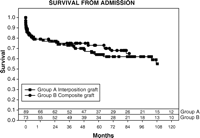
Actuarial survival estimates from admission, subdivided by surgical group.
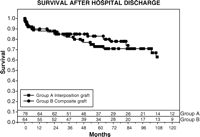
Actuarial survival estimates from hospital discharge, subdivided by surgical group.

Cumulative probability bar chart depicting outcomes with respect to proximal reoperation.
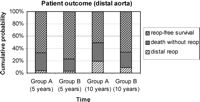
Cumulative probability bar chart depicting outcomes with respect to distal reoperation.
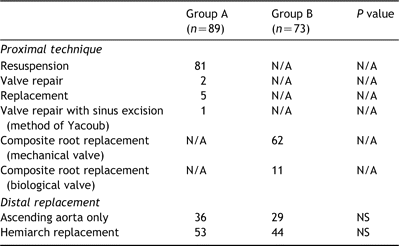
Method of proximal aortic reconstruction and extent of distal replacement
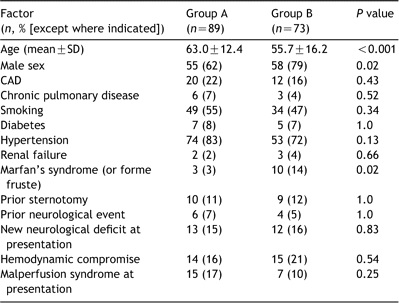
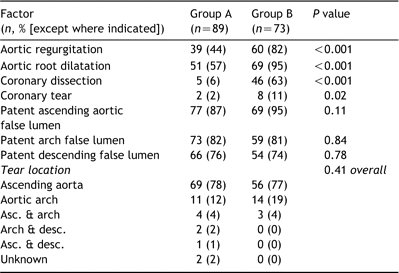
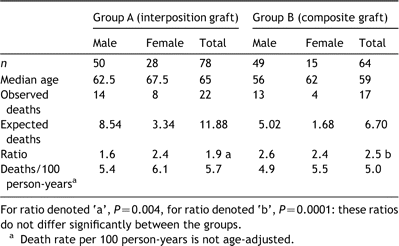
Survival after hospital discharge compared with New York State rates for 1990
Appendix A. Conference discussion
Dr J. Tan (Southport, Australia): Your paper certainly reflects our view on this condition. We generally attempt to perform a composite graft. Do you have any information about the patients who were not included in your database? In other words, patients who presented to your hospital with a type A dissection, were they all included in the database?
Dr Halstead: The only patients that were excluded from this series of acute type A dissection patients having surgery at Mount Sinai were a small number of total arch cases. They numbered 17 over the time course of this series, and they were excluded in order for us to have a series that had a homogenous approach to the distal aorta such that differences in survival and distal reoperation could reflect the surgical strategy with respect to the ascending aorta and the aortic root rather than the strategy taken with respect to the aortic arch. Other than that, other than those 17 patients, it is a complete series.
Dr S. Takamoto (Tokyo, Japan): It is amazing that almost half of the patients were done with the composite graft. For me, in Japan, the composite graft is used in less than 10% of the patients. It might be because the indication is different. If the dissection extended to the coronary arteries, even though the tear does not exist under the coronary ostium line to the annulus, we don't use the composite graft. Although the survival curve is not different between the two groups, the composite graft group needs warfarin for a long time, and long-term quality of life should be considered in the selection of the procedure. For a dissection patient who has been operated, the descending aorta is dissected and that disease remains for a long time. In such a case acute surgery sometimes is needed. If the patient is getting the warfarin, it is cumbersome to the patient and also for the surgeons. And the point on the quality of life, if the survival is not different, we should choose the interposition method. What do you think about that?
Dr Halstead: In response to your first point, I guess the difference in philosophy between the approach that many people take and the approach that Mount Sinai takes is really that most people would do a composite root replacement for irreparability of the aortic root, whereas at Mount Sinai it is undertaken really for irresectability of the dissection process. So if the dissection process extends down, let's say, into the noncoronary sinus, then that sinus will be resected right down to the annulus and a scalloped graft used to repair the aortic root, but in the presence of coronary sinus dissection, those coronary arteries are mobilized as buttons and a composite root replacement is undertaken in order to actually replace the dissected tissues rather than repair them.
With respect to your second point, that of quality of life, indeed it is quite possible that those patients, although they are younger, that receive a composite root replacement do have more frequent hospital admissions because of problems associated with anticoagulation. Again, it is certainly not proven. And we do have data on quality of life, but unfortunately it only appertains to the more recent years of the series. Because the series stretches back into the 1980s, one can only be confident about the incidence of reoperation and survival. The data with regards to softer endpoints, like quality of life, is incomplete in those early years, but subsequently we should be able to report on that because for the last 5 to 10 years the quality of life data has been far more complete.
Dr. R. De Paulis (Rome, Italy): In your follow-up of patients with supracoronary aortic replacement do you have the data about the progressive dilatation of the aortic root, dimension of the aortic root, and the incidence and degree of aortic regurgitation? Do you see any progression in both dimension and degree of aortic regurgitation?
Dr. Halstead: In this study, we have serial CT scans on these patients and we could interrogate those to yield data on progressive dilatation of the aortic root. Certainly there are more patients that developed aortic root dilatation, and the degree of aortic regurgitation in surgical Group A, those receiving a supracoronary interposition graft, then is reflected in the fact that 4 of them required proximal reoperation. But this study, you know, the endpoint that we chose to focus on really was the need for proximal reoperation, but I would suspect that if we looked across the series, we would find greater levels of mild and moderate aortic regurgitation that has not yet required surgical intervention.
Presented at the joint 18th Annual Meeting of the European Association for Cardio-thoracic Surgery and the 12th Annual Meeting of the European Society of Thoracic Surgeons, Leipzig, Germany, September 12–15, 2004




